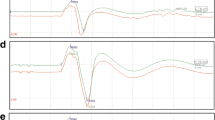Abstract
Eighteen patients with dural arteriovenous fistulas or intradural arteriovenous malformations underwent clinical and neurophysiological examination. Bladder disturbances, pain, sensory abnormalities and involvement of both upper and lower motor neurons were commonly observed. Abnormal findings were obtained both in electromyography (11/18) and somatosensory evoked potentials (16/18). The motor evoked potentials were abnormal in all but one patient and showed a prolonged central (n = 14) or peripheral motor conduction time (n = 6). In three cases both values were prolonged. The results of nerve conduction studies in the patients with prolonged peripheral motor conduction times were normal. These neurophysiological findings may indicate root involvement in some patients, probably due to venous congestion and consequent hypoxia, as there were no signs of root compression on neuroradiological evaluation in any of these six patients. Motor evoked potentials may provide an additional clue to the diagnosis, although patients with spinal stenosis or motor neuron disease may present with similar findings.
Similar content being viewed by others
References
Barrow DL, Colohan ART, Dawson R (1994) Intradural perimedullary arteriovenous fistulas (Type IV spinal cord arteriovenous malformations). J Neurosurg 81:221–229
Gueguen B, Merland JJ, Riche MC, Rey A (1987) Vascular malformations of the spinal cord: intrathecal perimedullary arteriovenous fistulas fed by medullary arteries. Neurology 37:969–979
Jellinger K, Minauf M, Garzuly F, Neumayer E (1968) Angiodysgenetische nekrotisierende Myelopathie (Bericht über 7 Fälle). Arch Psychiatr Nervenkr 211:377–404
Koenig E, Thron A, Schrader V, Dichgans J (1989) Spinal arteriovenous malformations and fistulae: clinical, neuroradiological and neurophysiological findings. J Neurol 236:260–266
Linden D, Berlit P (1994) Magnetic motor evoked potentials (MEP) in diseases of the spinal cord. Acta Neurol Scand 90:348–353
Mourier KL, Gobin YP, George B, Lot T, Merland JJ (1993) Intradural perimedullary arteriovenous fistulae: results of surgical and endovascular treatment in a series of 35 cases. Neurosurgery 32:885–891
Rosenblum B, Oldfield EH, Doppman JL, Di Chiro G (1987) Spinal arteriovenous malformations: a comparison of dural arteriovenous fistulas and intradural AVM's in 81 patients. J Neurosurg 67:795–802
Schrader V, Koenig E, Thron A, Dichgans J (1989) Neurophysiological characteristics of spinal arteriovenous malformations. Electromyogr Clin Neurophysiol 29:169–177
Thron A (1988) Vascular anatomy of the spinal cord. Neuroradiological inves-tigations and clinical syndromes. Springer, Berlin Heidelberg New York
Author information
Authors and Affiliations
Rights and permissions
About this article
Cite this article
Linden, D., Berlit, P. Spinal arteriovenous malformations: Clinical and neurophysiological findings. J Neurol 243, 9–12 (1996). https://doi.org/10.1007/BF00878524
Received:
Revised:
Accepted:
Issue Date:
DOI: https://doi.org/10.1007/BF00878524




